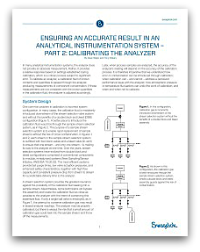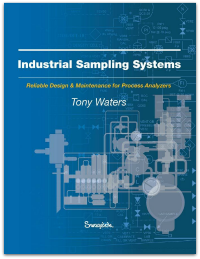Share this
Getting Accurate Results from Analyzers, Part 2: Calibration
by Jeff Hopkins on 6/14/18 8:45 AM
How you calibrate determines results. And it's easy to get wrong.
"Sampling system mistakes are always costly, are sometimes dangerous, and often go undetected. Incredibly, few colleges and universities offer sampling system design in their curricula."
- Art Anton, CEO, Swagelok Co, in Forward to Industrial Sampling Systems
In many analytical instrumentation systems, the analyzer doesn't give an absolute measurement. Instead, it gives a relative response based on settings established during calibration. To calibrate an analyzer, you pass a calibration fluid of known contents and quantities through the analyzer. If the resulting measurements don't match the known quantities in the calibration fluid, the analyzer must be adjusted.
In the first post of this three-part series, we looked at the problem of time delay. This time, we'll examine how errors or contamination can be introduced through calibration of the analyzer.
System design
One common problem is incorrect system configuration, such as introducing the calibration fluid downstream of the stream selection valve system, and without the benefits of a double block and bleed configuration. A better place to introduce the calibration fluid would be through the sample stream selection system. The purpose of a sample stream selection system is to enable rapid replacement of sample streams without the risk of cross contamination.
Nevertheless, some technicians bypass this assembly and introduce the calibration fluid as close as possible to the analyzer in order to conserve this expensive fluid. The analyzer may be properly calibrated, but there is always the risk that a small amount of calibration gas could leak into the sample stream and throw off the measurements.
In some applications, the U.S. EPA requires that the calibration fluid be introduced at an early point in the sampling system, usually near the probe. The reasoning is that the calibration fluid should be subjected to all the same variables as the sample stream. This makes good sense, and such a setup will provide a fair estimate of the amount of time it takes for a sample to travel from the probe to the analyzer.
As we noted in Part 1 of this series, that period of time is often underestimated or unknown. However, that also requires a relatively large amount of calibration fluid. A good compromise is to run the calibration fluid through the sample stream selection system, dedicating one stream to the fluid.

Ensuring an Accurate Result in an Analytical Instrumentation System, Part 2: Calibrating the Analyzer (PDF)
Precision and accuracy
There are some things that calibration can correct, and some that it can't. Let’s start with the difference between precision and accuracy.Imagine a shooter’s target. If the holes in the target are tightly grouped, we can say that the shooter is precise. Precision yields repeatable outcomes.
But if that tight grouping is on the outer edge of the target instead of the bull's eye, the shooter is not accurate. A tight grouping in the center of the target shows that the shooter is both precise and accurate.
Likewise, an analyzer must first be precise. It must yield repeatable results with a known quantity of calibration fluid. If it doesn't, the analyzer is malfunctioning or the system is not maintaining the sample at constant conditions. Calibration cannot correct for imprecision.
If the analyzer produces consistent results but the results don't match the calibration fluid, then the analyzer is inaccurate. Accuracy can and should be addressed through calibration. This is called correcting the bias.

Download an excerpt of this book on designing and operating a sampling system for a process analyzer.
Positive and negative interference
Even if the analyzer is precise and accurate, it still might yield inaccurate results when analyzing the sample stream. If the analyzer is asked to count red molecules and it encounters pink ones, what does it do? The pink molecules look red to the analyzer, so it counts them as red. This is called positive interference.
No analyzer is perfect, but they all strive for “selectivity,” which means they respond to just the molecules you want them to and not to anything else. Some analyzers are more complex and are programmed to chemically inhibit certain types of interference.
Another type of interference is negative interference: A molecule that should be counted isn’t counted because another molecule is hiding it. For example, in fluorinated drinking water, an electrode is used to analyze the amount of fluoride in the water. However, hydrogen ions, which are common in drinking water, hide the fluoride so the count is inaccurately low. The solution is to remove the source of interference. By introducing a buffer solution, the hydrogen ions are removed and the electrode can accurately measure the fluoride.
Atmospheric changes
So, calibration has its limitations. Gas analyzers are essentially molecule counters. What happens when the atmospheric pressure changes by 5 percent to 10 percent? The number of molecules in a given volume will change, and as a result the analyzer’s count will change.
In order for calibration to be effective, absolute pressure in the sampling system must remain the same during calibration and during analysis of samples. Absolute pressure would be the system pressure as measured by a gauge, plus atmospheric pressure.
Validation versus calibration
The best method for calibration employs an automated system of regular validation, with statistical process control. Validation means checking the analyzer at regular time intervals to see whether it is on or off the target. It is the same process as calibration, except that no correction is made.
An automated system will run a validation check, usually once a day, and analyze the outcome for any problem that would require an adjustment or recalibration. A human being can manually validate a system, but more often than not, the human being also will make an adjustment to the analyzer, even if the system is just 1 percent off. A series of occasional and minor adjustments will introduce additional variance and make it difficult to analyze trends and determine when the system is truly running off course.
It is better to allow an automated system to run unattended. Download a free, four-page technical paper that covers this information in much greater detail, including more examples. For even more information, see the Swagelok book Industrial Sampling Systems (2013), the definitive sampling systems reference guide by expert Tony Waters.
Next up: We'll look at the importance of maintaining a representative sample and the corrective actions you can take to ensure you get one.
More like this:
- Getting Accurate Results from Analyzers, Part 1 (blog article)
- Tony Waters Wrote the Book on Industrial Sampling Systems (blog article)
- Technical Webinar: Pre-Engineered Subsystems (PDF & webinar access page)
Share this
- Archive (465)
- Assembly Services (207)
- About (100)
- Seal Support Systems (96)
- Best Practices (88)
- Training Services (74)
- Fittings (51)
- Semiconductor Applications (49)
- Hoses and Flexible Tubing (47)
- Regulators (44)
- Tubing (42)
- Grab Sampling Systems (32)
- Sampling Systems (32)
- Gas Systems (30)
- Services (30)
- Downloads (29)
- Valves (24)
- Application Support (18)
- Orbital Welding (17)
- Case Studies (13)
- Steam Systems (13)
- Frequently Asked Questions (12)
- Tools (12)
- Measurement Devices (7)
- Subsystems (6)
- Thermal Management (6)
- September 2023 (1)
- August 2023 (2)
- June 2023 (1)
- March 2023 (3)
- February 2023 (3)
- January 2023 (4)
- December 2022 (4)
- November 2022 (4)
- October 2022 (4)
- September 2022 (1)
- August 2022 (3)
- July 2022 (2)
- June 2022 (4)
- May 2022 (1)
- April 2022 (2)
- March 2022 (1)
- February 2022 (2)
- January 2022 (3)
- December 2021 (1)
- November 2021 (6)
- October 2021 (6)
- September 2021 (8)
- August 2021 (4)
- July 2021 (3)
- June 2021 (6)
- May 2021 (6)
- April 2021 (7)
- March 2021 (5)
- February 2021 (4)
- January 2021 (6)
- December 2020 (5)
- November 2020 (6)
- October 2020 (6)
- September 2020 (8)
- August 2020 (7)
- July 2020 (8)
- June 2020 (8)
- May 2020 (6)
- April 2020 (9)
- March 2020 (7)
- February 2020 (10)
- January 2020 (21)
- December 2019 (23)
- November 2019 (21)
- October 2019 (22)
- September 2019 (21)
- August 2019 (22)
- July 2019 (23)
- June 2019 (20)
- May 2019 (23)
- April 2019 (22)
- March 2019 (21)
- February 2019 (20)
- January 2019 (21)
- December 2018 (14)
- November 2018 (19)
- October 2018 (23)
- September 2018 (17)
- August 2018 (29)
- July 2018 (11)
- June 2018 (6)
- May 2018 (5)
- April 2018 (4)
- March 2018 (5)
- February 2018 (3)
- January 2018 (3)
- December 2017 (2)
- November 2017 (4)
- October 2017 (3)
- September 2017 (2)
- August 2017 (6)
- July 2017 (4)
- June 2017 (4)
- May 2017 (4)
- April 2017 (3)
- March 2017 (4)
- February 2017 (3)
- January 2017 (3)
- December 2016 (3)
- November 2016 (3)
- October 2016 (3)
- September 2016 (5)
- August 2016 (5)
- July 2016 (4)
- June 2016 (5)
- May 2016 (3)
- April 2016 (4)
- March 2016 (5)
- February 2016 (11)
- January 2016 (1)
- December 2015 (3)
- November 2015 (4)
- October 2015 (3)
- September 2015 (4)
- August 2015 (4)
- July 2015 (8)
- June 2015 (5)
- May 2015 (3)
- April 2015 (4)
- March 2015 (4)
- February 2015 (3)
- January 2015 (4)
- December 2014 (2)
- November 2014 (3)
- October 2014 (4)
- September 2014 (4)
- August 2014 (4)
- July 2014 (5)
- June 2014 (4)
- May 2014 (4)
- April 2014 (5)
- March 2014 (4)
- February 2014 (3)
- January 2014 (4)
- December 2013 (5)
- November 2013 (3)
- October 2013 (4)
- September 2013 (3)
- August 2013 (5)
- July 2013 (5)
- June 2013 (5)
- May 2013 (3)
- April 2013 (6)
- March 2013 (4)
- February 2013 (4)
- January 2013 (8)
- December 2012 (4)
- November 2012 (6)
- October 2012 (6)
- September 2012 (4)
- August 2012 (4)
- July 2012 (4)
- June 2012 (4)

.webp?width=210&height=70&name=StickyLogo%20(5).webp)


